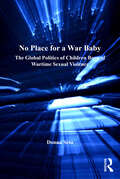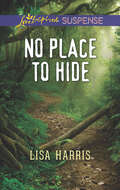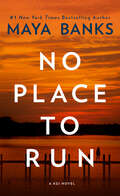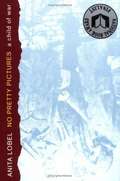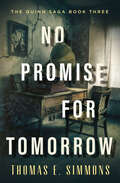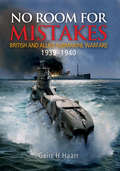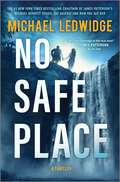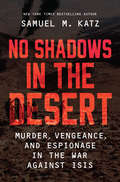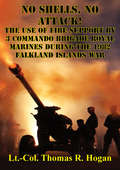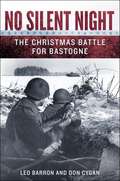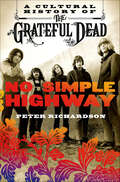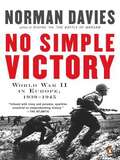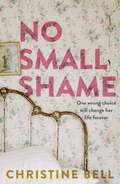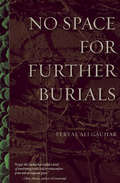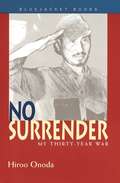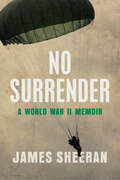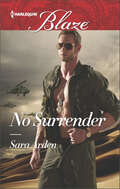- Table View
- List View
No Place for a War Baby: The Global Politics of Children born of Wartime Sexual Violence (Gender in a Global/Local World)
by Donna SetoDonna Seto investigates why children born of wartime sexual violence are rarely included in post-conflict processes of reconciliation and recovery. The focus on children born of wartime sexual violence questions the framework of understanding war and recognizes that certain individuals are often forgotten or neglected. This book considers how children are neglected sites for the reproduction of global norms. It approaches this topic through an interdisciplinary perspective that questions how silence surrounding the issue of wartime sexual violence has prevented justice for children born of war from being achieved. In considering this, Seto examines how the theories and practices of mainstream International Relations (IR) can silence the experiences of war rape survivors and children born of wartime sexual violence and explores the theoretical frameworks within IR and the institutional structures that uphold protection regimes for children and women.
No Place to Hide
by Lisa HarrisA witness to murder is on the run through the Brazilian rain forest in this inspirational and action-packed romantic thriller.Former navy diver Ryan Kendall is sent to Brazil with a simple assignment: find compromised witness Ellie Webb and bring her home safely. But Ellie isn’t going home until she gets evidence against the criminals who killed her father. As she treks into the Amazon to find it, Ryan must protect her. With cartel members and pirates close behind, they will need to find all their faith, strength, and trust in each other to survive the dangerous jungle . . . and take down a killer.
No Place to Hide: A Novel of the Vietnam War
by Gerry CarrollApril, 1975: Two years after the United States pulled its last ground combat troops out of South Vietnam; the ARVN (South Vietnamese Army) is waging a final, desperate fight in a war it cannot win. As the North Vietnamese Army smashes its way toward Saigon, a skeleton crew of American officers are faced with the evacuation of all remaining American and Vietnamese personnel associated with the now-abandoned U.S. war effort. Among the Americans assisting in the effort are some of the Navy's most dedicated warriors. Search and Rescue (SAR) pilot Lt. Tim Boyle, renowned for his bravery, is called back in-country to help coordinate the "helo" end of the operation. His best friend, A-7 Corsair pilot Mike Santy, is assigned as an air wing representative to the evacuation team. Years before, Boyle and Santy had faced a harrowing escape on the ground in North Vietnam after a failed SAR. Now, they're flying one last mission. Lt. Kevin Thompson and junior officer Mark Dalton, Navy SEALs working alongside Boyle and Santy, set out through the NVA-infested jungle to search for Tony Butler. A SEAL who, for the last seven years, has been leading an army of Montagnard tribesmen in their fight against the North Vietnamese, Butler is ready to come home. As the NVA closes in on the doomed city of Saigon, Thompson and Dalton must use all their stealth and cunning to locate Butler - and avoid certain death at enemy hands. In an extraordinary act of daring, Boyle and Santy commandeer an Air America "Huey" on an adrenaline-pumping SAR to try to evacuate the stranded team before the final collapse.
No Place to Run (A KGI Novel #2)
by Maya BanksA woman&’s first love becomes her only chance for survival in this gripping novel in Maya Banks&’ KGI series. The last person Sam Kelly expected to pull wounded from the lake was Sophie Lundgren. Once they shared a brief, intense affair while Sam was undercover and then she vanished. She&’s spent the last months on the run, knowing that any mistake would cost her life and that of her unborn child—Sam&’s child. Now she&’s resurfaced with a warning for Sam: this time, he&’s the one in danger.Sam has too many questions to let her slip away again—like why she disappeared in the first place. This time he vows not to be seduced. But one look in her eyes, and the passion burns again, and Sam knows he&’ll do anything to keep her and his child safe. However, Sophie&’s dark past is more dangerous than he imagines, and the only way for either to survive it is to outrun it.
No Plan B: A Jack Reacher Novel (Jack Reacher #27)
by Lee Child Andrew Child#1 NEW YORK TIMES BESTSELLER • Don&’t miss the hit streaming series Reacher! &“No Plan B is not to be missed. A perfectly plotted, fast-paced thriller, with bigger twists than ever before. It&’s no wonder Jack Reacher is everyone&’s favorite rebel hero.&”—Karin SlaughterONE OF THE BEST BOOKS OF THE YEAR: Reader&’s DigestIn Gerrardsville, Colorado, a woman dies under the wheels of a moving bus. The death is ruled a suicide. But Jack Reacher saw what really happened: A man in a gray hoodie and jeans, moving stealthily, pushed the victim to her demise—before swiftly grabbing the dead woman&’s purse and strolling away. When another homicide is ruled an accident, Reacher knows this is no coincidence. With a killer on the loose, Reacher has no time to waste to track down those responsible. But Reacher is unaware that these crimes are part of something much larger and more far-reaching: an arsonist out for revenge, a foster kid on the run, a cabal of powerful people involved in a secret conspiracy with many moving parts. There is no room for error, but they make a grave one. They don&’t consider Reacher a threat. &“There&’s too much at stake to start running from shadows.&” But Reacher isn&’t a shadow. He is flesh and blood. And relentless when it comes to making things right.For when the threat is Reacher, there is No Plan B.
No Pretty Pictures: A Child of War
by Anita LobelA finalist for the National Book Award, Lobel's unforgettable memoir paints a disturbing picture of a child hiding from the Nazis in World War II. Since coming to the United States as a teenager, Lobel has spent her life as an author and illustrator of picture books.
No Promise for Tomorrow (The Quinn Saga)
by Thomas E. SimmonsIn the third volume of the Quinn family saga, Ansel Quinn is caught in an international scandal with reverberations across two world wars. In 1916, the world waits with bated breath to see if the United States will enter the Great War raging in Europe. Meanwhile, President Wilson campaigns for reelection on his record of keeping America out of the fray. Caught in the middle is Maj. Ansel Quinn of Mississippi, assigned to the French army headquarters in Paris as a neutral observer. At home, Ansel&’s wife, Isabel, has been left to manage the family&’s cotton plantation in Mississippi as well as their sugar plantation in Cuba. It is a trial to be without her husband, but only the beginning of the hardships she will face. When Ansel is wounded on the frontlines of the Somme—far from where any neutral observer should be—it sets off international intrigue that could change the course of history. In No Promise for Tomorrow, the Quinn family struggles across the decades between World War I and World War II—a period that includes the influenza epidemic, the Roaring Twenties, prohibition, and the Great Depression.
No Quarter Given: The Change In Strategic Bombing Application In The Pacific Theater During World War II
by Major John M. CuratolaEuropean airpower theorists of the 1920's and 30's envisioned the deliberate bombing of civilians in order to affect an enemy nation's wartime production capabilities and national morale. However, American proponents of airpower were more exacting in their approach to the use of the airplane. The US Army Air Corps developed the idea of precision bombing as a means to destroy an enemy's ability to prosecute war through the targeting of only an enemy's means of production and state infrastructure while avoiding civilian casualties.World War II provided the US Army Air Force (USAAF) the opportunity to prove the effectiveness of this theory. However, as the war progressed, the USAAF targeted not just centers of production, but political targets as well as civilian populations. Thus, USAAF bombing came to resemble the type of application that was initially proffered by European theorists. Large-scale bombing of cities and populations became the mode of operation for the USAAF in the Pacific. Despite its policies and doctrine, the USAAF deliberately bombed civilian populations in conjunction with the Japanese means of production. Why did this targeting change take place? How did the USAAF eventually come to conduct indiscriminate area bombing of civilians despite the perception that it was contrary to our national mores?
No Quarter: The Battle of the Crater, 1864
by Richard SlotkinIn this richly researched and dramatic work of military history, eminent historian Richard Slotkin recounts one of the Civil War's most pivotal events: the Battle of the Crater on July 30, 1864. At first glance, the Union's plan seemed brilliant: A regiment of miners would burrow beneath a Confederate fort, pack the tunnel with explosives, and blow a hole in the enemy lines. Then a specially trained division of African American infantry would spearhead a powerful assault to exploit the breach created by the explosion. Thus, in one decisive action, the Union would marshal its mastery of technology and resources, as well as demonstrate the superior morale generated by the Army of the Potomac's embrace of emancipation. At stake was the chance to drive General Robert E. Lee's Army of Northern Virginia away from the defense of the Confederate capital of Richmond - and end the war. The result was something far different. The attack was hamstrung by incompetent leadership and politi - cal infighting in the Union command. The massive explosion ripped open an immense crater, which became a death trap for troops that tried to pass through it. Thousands of soldiers on both sides lost their lives in savage trench warfare that prefigured the brutal combat of World War I. But the fighting here was intensified by racial hatred, with cries on both sides of "No quarter!" In a final horror, the battle ended with the massacre of wounded or surrendering Black troops by the Rebels - and by some of their White comrades in arms. The great attack ended in bloody failure, and the war would be prolonged for another year. With gripping and unforgettable depictions of battle and detailed character portraits of soldiers and statesmen, No Quarter compellingly re - creates in human scale an event epic in scope and mind-boggling in its cost of life. In using the Battle of the Crater as a lens through which to focus the political and social ramifications of the Civil War - particularly the racial tensions on both sides of the struggle - Richard Slotkin brings to readers a fresh perspective on perhaps the most consequential period in American history.
No Regrets: A Novel of Love, Lies, Truth and Soulmates in W. W. II England
by Mary Christian PayneSoul mates are torn apart by war in this captivating, straight-from-the-heart historical romance—first in the unforgettable Thornton Trilogy. Sloan Thornton is the heir to Highcroft Hall, the family seat of the Earl of Wessex, in the quaint village of Thornton-on-Sea on the southeast coast of England. He has always dreamed of finding his soul mate. Just before he leaves to fight in World War II, as an RAF pilot, he proposes to his childhood sweetheart, Anne. There is no question how deep his devotion is to her, and how naturally they bring out the best in each other.One fateful afternoon overseas, Sloan encounters Elise in a rural farmhouse on a French country road. It is May, 1940, and the Dunkirk Beaches are being evacuated. Sloan is wounded when his plane is shot down by the Luftwaffe. After he meets Elise, he can never forget her. He carries her memory with him throughout the war. In the meantime, Elise suffers terrifying misfortune.When they meet again for the first time in five years, the spark is still there. But, there is still Anne, who refuses to be left heartbroken and rejected. Sloan begins to question whether the life he’s living is the one he’s meant to live. Elise wonders the same thing.No Regrets is a powerful story about one woman at the crossroads of true love and real life.Don’t miss the next two books in the Thornton Trilogy: No Gentleman and No Secrets.
No Room for Error: The Story Behind the USAF Special Tactics Unit
by Benjamin F. Schemmer John T. Carney"John Carney is one of the few heroes I have." -LT. COL. L. H. "BUCKY" BURRUSS, USA (Ret.) Founding member and Deputy Commander of Delta Force. When the U. S. Air Force decided to create an elite "special tactics" team in the late 1970s to work in conjunction with special-operations forces combating terrorists and hijackers and defusing explosive international emergencies, John T. Carney was the man they turned to. Since then Carney and the U. S. Air Force Special Tactical units have circled the world on sensitive clandestine missions. They have operated behind enemy lines gathering vital intelligence. They have combated terrorists and overthrown dangerous dictators. They have suffered many times the casualty rate of America's conventional forces. But they have gotten the job done--most recently in stunning victories in the war on terrorism in Afghanistan, which Carney calls "America's first special-operations war." Now, for the first time, Colonel Carney lifts the veil of secrecy and reveals what really goes on inside the special-operations forces that are at the forefront of contemporary warfare. Part memoir, part military history, No Room for Error reveals how Carney, after a decade of military service, was handpicked to organize a small, under-funded, classified ad hoc unit known as Brand X, which even his boss knew very little about. Here Carney recounts the challenging missions: the secret reconnaissance in the desert of north-central Iran during the hostage crisis; the simple rescue operation in Grenada that turned into a prolonged bloody struggle. With Operation Just Cause in Panama, the Special Tactical units scored a major success, as they took down the corrupt regime of General Noriega with lightning speed. Desert Storm was another triumph, with Carney's team carrying out vital search-and-rescue missions as well as helping to hunt down mobile Scud missiles deep inside Iraq. Now with the war on terrorism in Afghanistan, special operations have come into their own, and Carney includes a chapter detailing exactly how the Air Force Special Tactics d. c. units have spearheaded the successful campaign against the Taliban and Al Qaeda. Gripping in its battle scenes, eye-opening in its revelations, No Room for Error is the first insider's account of how special operations are changing the way modern wars are fought. Col. John T. Carney is an airman America can be proud of, and he has written an absolutely superb book.
No Room for Mistakes: British and Allied Submarine Warfare, 1939–1940
by Geirr H HaarrA new book from this bestselling author covering the events at sea in the early years of World War II, in which he has compiled comprehensive research and insight into a highly readable and detailed account of British and Allied submarine warfare in north European waters at the beginning of the war. The early chapters describe prewar submarine development, including technical advances and limitations, weapons, tactical use and life onboard, and examine the men who crewed them and explore their understanding of the warfare that they would become involved in.The core of the book is an account of the events as they unfolded in 'home waters' from the outset of war to the end of 1940, by which time the majority of the Allied submarines were operating in the Mediterranean. It is a story of success, triumph, failure and tragedy, and it tells of the tremendous courage and endurance shown by a small group of men learning how to fight a new kind of war in claustrophobic, sub-sea vessels with limited information about the enemy, or what they would meet off the alien coasts to which they were heading. Extensive primary sources are used to document the many aspects of this war, some of which remain controversial to this day. Max Horton, Vice Admiral Submarines 1940, said: 'There is no room for mistakes in submarines. You are either alive or dead.' This book makes plain how right he was.
No Safe Place: A Thriller (Michael Gannon Series #4)
by Michael LedwidgeTHE NEXT THRILLER BY THE #1 NEW YORK TIMES BESTSELLING COAUTHOR OF JAMES PATTERSON'S MICHAEL BENNETT SERIES While he's hiding out off the grid on a trout stream in the middle of rural New England, the last thing Mike Gannon is looking for is any more trouble. But then he bumps into an old girlfriend who is an investigator up from New York City looking into the mysterious death of a student at a nearby prestigious college. And soon what Mike wants and what he&’s about to get become two very different things. First a whistleblower comes forward with evidence of a deadly scandal. Then shortly after arrives a group of dangerous men who will do anything to keep secrets buried. Then the lights go out.No Safe Place is Mike Gannon&’s most nail-biting, most hair-raising, most suspenseful and satisfying and thrilling adventure yet.
No Secrets: A Young Lady's Search for Answers (The Thornton Trilogy #3)
by Mary Christian PayneIn this novel, twenty-two years after a horrific act befell her mother, a young woman embarks on a journey of justice and self-discovery.Elise Thornton has tried for twenty-two years to keep the truth from her daughter Chloe about how she was conceived when her mother was raped by three Nazi soldiers on the day of the Battle of Dunkirk in 1940. But finally, the truth comes out, and there are no more secrets to hide . . .Chloe is shocked at the revelation and vows to find the men who perpetrated the vile act. Teaming up with her dear friend’s grandson, Sterling Sheppard, they make plans to hunt down the wretched men and bring them to justice.During the course of their journey, Chloe learns the true meaning of words like “father” and “brother” and comes to understand that the world is not always black and white. For the first time in her life, Chloe opens her mind to the possibility of love and realizes that people grow and change as they mature.This is an engaging and heartwarming story, bringing to a conclusion the lives of the reader’s favorite residents of Thornton-on-Sea.
No Shadows in the Desert: Murder, Vengeance, and Espionage in the War Against ISIS
by Samuel M. KatzThe inside story of the covert operation that took down the heads of ISISNo Shadows in the Desert reveals the untold story of the behind-the-scenes fight against ISIS—one coordinated by heads of state and ultimately fought in the alleyways and open deserts of the Middle Eastern battlefield by spies and soldiers. Samuel M. Katz draws upon his sources within the global intelligence and counterterrorism community, as well as the international special operations and espionage fraternity, to tell the story of the covert campaign against ISIS by the operatives who ventured deeply and secretly into enemy territory.In this first-ever look at the secret inner workings of an Arab secret service, Katz tells the story of Jordan’s GID, the masters of human intelligence on the espionage battlefields of the Middle East, who proved pivotal and crucial go-to allies of the CIA and America’s other intelligence agencies in the war against ISIS and the war on terror. With the revealing and intimate insight of the intelligence officers who fought ISIS, No Shadows in the Desert is a rare glimpse into how a strategic partnership helped change how terrorism is fought in the Middle East and beyond.
No Shells, No Attack! - The Use Of Fire Support By 3 Commando Brigade Royal Marines During The 1982 Falkland Islands War
by Lieutenant Colonel Thomas R. HoganThe 1982 British campaign to recapture the Falkland Islands was a naval operation of relatively short duration. Nevertheless, many of the British lessons learned are applicable to the U.S. Army. No notice deployment, assignment as part of a naval landing force, and combat operations beyond the range of land based close air support are all reasonable missions for light divisions. This study analyzes one aspect of the British experience-the use of fire support by 3 Commando Brigade Royal Marines. Through historical review, the study examines the use of mortars, artillery, naval gunfire, and close air support to complement ground maneuver. The purpose behind the study is to highlight the effectiveness with which 3 Commando Brigade utilized fire support during an island invasion, slightly more than one year before the U.S. Army experience in Grenada. Conclusions focus on three areas. In the first area, fire support relationships, the study contends that the British marriage of maneuver and fire support is exceptionally strong and that the strength is largely attributable to the utilization of the artillery battery commander at maneuver battalion headquarters. In the second area, fire support for naval operations, the importance of Army interoperability with naval gunfire and air support is developed. In the third area, fire support effects, the study asserts that the mental effects of fire support were a major contributor to British victory.
No Silent Night: The Christmas Battle for Bastogne
by Leo Barron Don CyganOn Christmas morning, 1944, there was little reason to celebrate. ... As the Battle of the Bulge raged, a small force of American solders-including the famed 101st Airborne division, tank destroyer crews, engineers, and artillerymen-was completely surrounded by Hitler’s armies in the Belgian town of Bastogne. Taking the town was imperative to Hitler’s desperate plan to drive back the Allies and turn the tide of the war. The attack would come just before dawn. As the outnumbered, undersupplied Americans gathered in church for services or shivered in their snow-covered foxholes on the fringes of the front lines, freshly reinforced German forces of men and tanks attacked. The battle was up close and personal, with the cold, exhausted soldiers of both armies fighting for every square foot of frozen earth. In the end, the Allied forces would hold the town of Bastogne, with the hard-won victory boosting morale and sounding the death-knell for Hitler’s Third Reich. After this battle, the Nazis would never go on the offensive again. Featuring interviews with the soldiers who were there, as well as never-before-seen or translated documents, No Silent Night is a compelling chronicle of one day that changed the course of the war-and the world. INCLUDES NEVER-BEFORE-SEEN PHOTOS AND MAPS .
No Simple Highway: A Cultural History of the Grateful Dead
by Peter RichardsonFor almost three decades, the Grateful Dead was America's most popular touring band. No Simple Highway is the first book to ask the simple question of why—and attempt to answer it. Drawing on new research, interviews, and a fresh supply of material from the Grateful Dead archives, author Peter Richardson vividly recounts the Dead's colorful history, adding new insight into everything from the Acid Tests to the band's formation of their own record label to their massive late career success, while probing the riddle of the Dead's vast and durable appeal. Arguing that the band successfully tapped three powerful utopian ideals—for ecstasy, mobility, and community—it also shows how the Dead's lived experience with these ideals struck deep chords with two generations of American youth and continues today.Routinely caricatured by the mainstream media, the Grateful Dead are often portrayed as grizzled hippy throwbacks with a cult following of burned-out stoners. No Simple Highway corrects that impression, revealing them to be one of the most popular, versatile, and resilient music ensembles in the second half of the twentieth century. The band's history has been well-documented by insiders, but its unique and sustained appeal has yet to be explored fully. At last, this legendary American musical institution is given the serious and entertaining examination it richly deserves.
No Simple Victory
by Norman DaviesWhat was the biggest operation of World War II in Europe? It wasnt D-Day. What was the name of the largest concentration camp operating in Europe between 1939 and 1945. It wasnt Auschwitz. What European nationality lost the largest number of civilians between 1939 and 1945? It wasnt the Frenchor the Germans. Bringing his usual fresh eye to bear on a story we all think we know, Norman Davies answers these questions, and many more, in this concise, vivid, and thought-provoking new history of the Second World War. Powerfully argued, compellingly written and devastating in its conclusions, Davies forces us to look again at those six years and to discard the usual narrative of Allied good versus Nazi evil. He reminds us that for the greater part of the continent, the Allied victory and the liberation of Europe was the beginning of more than 50 years of totalitarian oppression.
No Small Shame: One wrong choice will change her life forever
by Christine BellAustralia, 1914. The world is erupting in war. Jobs are scarce and immigrants unwelcome. For young Catholic Mary O&’Donnell, this is not the new life she imagined. When one foolish night of passion leads to an unexpected pregnancy and a loveless marriage, Mary&’s reluctant husband Liam escapes to the trenches. With her overbearing mother attempting to control her every decision, Mary flees to Melbourne determined to build a life for herself and her child. There, she forms an unlikely friendship with Protestant army reject Tom Robbins. But as a shattering betrayal is revealed, Mary must make an impossible choice. Does she embrace the path fate has set for her, or follow the one she longs to take? From the harshness of a pit village in Scotland to the upheaval of wartime Australia, No Small Shame tells the moving story of love and duty, loyalty and betrayal, and confronting the past before you can seek a future.
No Space for Further Burials: A Novel
by Feryal Ali GauharA brutal and &“fascinating&” novel of an American held captive in an asylum in Afghanistan (Stewart O&’Nan). Set in Afghanistan in 2002, No Space for Further Burials is a chilling indictment of the madness of war and our collective complicity in the perpetuation of violence. The novel&’s narrator, a US Army medical technician in Afghanistan helping to &“liberate&” the country from the Taliban, has been captured by rebels and thrown into an asylum. The other inmates are a besieged gathering of society&’s forgotten and unwanted refugees and derelicts, disabled and different, resilient and maddened, struggling to survive the lunacy raging outside the asylum compound. The novel becomes a powerful evocation of the country&’s desolate history of plunder and war, waged by insiders and outsiders, all fueled by ideology, desperation, and greed. This astonishingly powerful story unfolds the tragedy of Afghanistan, as told by the captive narrator in hauntingly beautiful prose. While the characters try to cope with their individual destinies, the terrible madness of war is counterpointed with the poignancy of their lives and the narrator&’s own peculiar predicament—the &“victor&” now a victim, his ambivalence a metaphor for everything Afghanistan symbolizes. &“A novel of unrelenting truth held in transcendent prose and an exquisite grace. There is no easy redemption here, but there is light and more light.&” —Chris Abani, author of GraceLand and Song for Night &“In writing through the eyes of an American captive in Afghanistan, Feryal Ali Gauhar has fashioned a fascinating two-way mirror in which we see the author creating an Other confronting Otherness. As in Richard Powers&’ hostage novel Ploughing in the Dark, the mask of character reveals as much as it conceals.&” —Stewart O&’Nan, author of Songs for the Missing &“An unbearably beautiful book, one you will not soon forget . . . What Gauhar shows us is that in a war there are only those who die and those who survive, and sometimes even those lines get blurred. And that&’s what keeps you hungrily turning the pages.&” —Radhika Jha, author of Smell
No Substitute for Victory: Successful American Military Strategies from the Revolutionary War to the Present Day
by David RigbyAn important look at how America has won its wars in the past and how it can continue winning in the future.Is there a recipe for military success? In No Substitute for Victory, author David Rigby grapples with this issue and determines that, in the case of the United States, there are a number of different strategies that have brought victory in battle to American forces over the years.In a clear, energetic prose, Rigby explains how the dropping of chocolate bars from airplanes over Berlin turned out to be one of the most successful applications of the Cold War strategy of containment. He argues, too, that far from being a radical change in policy by a desperate President Lincoln, the Emancipation Proclamation was in fact an essential part of Lincoln's plan to reunite the nation. While the focus in No Substitute for Victory is on military maneuvers that have been successful, Rigby brilliantly uses the Vietnam War as a touchstone for comparison purposes on how not to fight a war.While the writing of military strategy is a crowded field, Rigby's approach is unique in that he draws examples from conflicts throughout American history, from the Revolution up through the modern day. Rigby's ability to find similarities in-and to draw conclusions from-the successes attained by American forces in battles as seemingly dissimilar as Gettysburg and Midway makes No Substitute for Victory essential reading for anyone interested in the riveting history of our nation's military.
No Surrender
by Hiroo OnodaIn the spring of 1974, Second Lieutenant Hiroo Onoda of the Japanese army made world headlines when he emerged from the Philippine jungle after a thirty-year ordeal. Hunted in turn by American troops, the Philippine police, hostile islanders, and successive Japanese search parties, Onoda had skillfully outmaneuvered all his pursuers, convinced that World War II was still being fought and that one day his fellow soldiers would return victorious. This account of those years is an epic tale of the will to survive that offers a rare glimpse of man's invincible spirit, resourcefulness, and ingenuity. A hero to his people, Onoda wrote down his experiences soon after his return to civilization. This book was translated into English the following year and has enjoyed an approving audience ever since.
No Surrender
by James SheeranNo Surrender is the true story of an American WWII soldier who escaped a Nazi POW train and fought in the French Resistance, rivetingly told by the man himself.A paratrooper in the 101st Airborne, James Sheeran was just a kid when he floated into Normandy-part of the historic invasion that brought more than a hundred thousand Allied soldiers into Nazi-occupied France. He survived D-Day only to be captured by German forces. Barefoot, starved, and sleep-deprived, he was forced on a marathon march, exposed to fire from American fighter planes, and herded onto a train to Germany.But, using his jump knife, he carved his way out of the boxcar and leaped into the countryside. Stumbling into a French village, he found his way with the aid of the underground network, and fought alongside a guerrilla faction of the French Resistance.This gripping account of war-torn Europe is, ultimately, a story about humanity's capacity for self-sacrifice and remarkable endurance. Here Sheeran shares not only the details of his extraordinary wartime experience, but the private thoughts that guided him in his darkest moments. It is an unforgettable memoir that will speak to anyone who has faced adversity and refused to admit defeat.
No Surrender
by Sara ArdenSometimes the only way to forgiveness is sin... Sean Dryden-the superhot all-American golden boy-has always gotten under Kentucky Lee's skin. She can't remember a time when she wasn't in love with the Special Ops Aviation pilot...even when he got engaged to her best friend. What Kentucky never knew is that Sean broke it off with Lynnie just a week before she died. Something has come apart in Sean-too many missions, too much loss. Only Kentucky seems to understand him...and the undercurrent running between them is tangible. That need to touch and taste-to remind themselves they're still alive. Can the fire in her warm his frozen heart?
